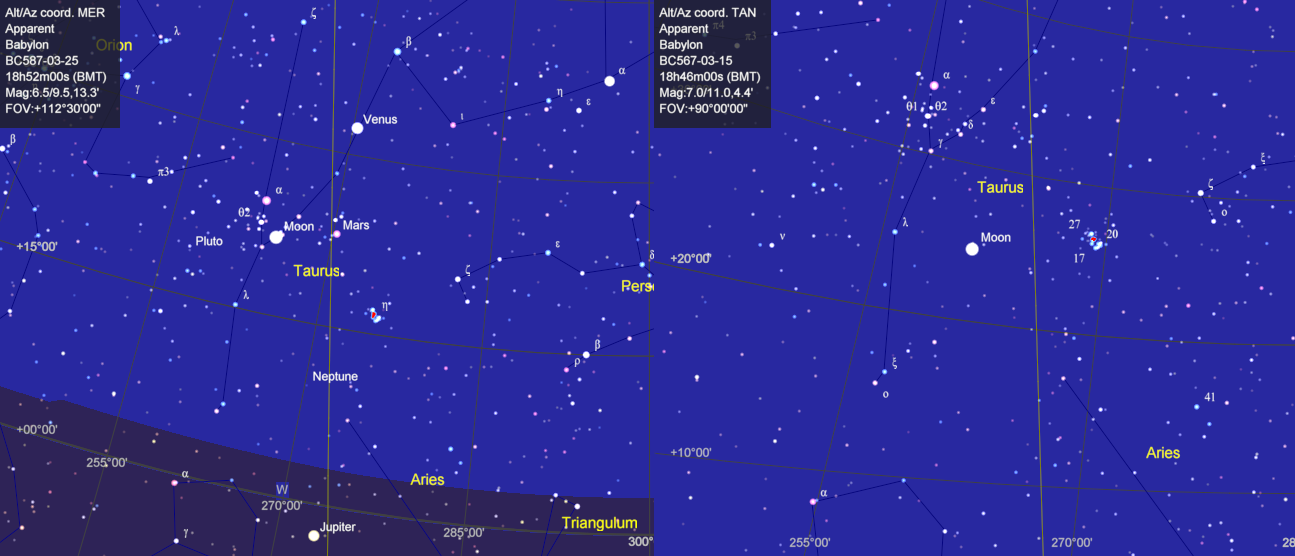Note
Moon position 12
the moon was balanced 4 cubits below η Tauri
MULx.MULx can refer to the whole constellation of the Bull, or the Jaw of the Bull or Mars (amongst others). - P. Felix Gössman; Planetarium Babylonicum (1950) pg 109, 23, 110. In later diaries it generally refers to η Tauri. It can also represent the brightest star in the Bull of Heaven (α Tauri) - P. Felix Gössman; Planetarium Babylonicum (1950) pg 24.

η Tauri is marked in red.
Position 11 | Position 12 | Position 13
Note A
| Symbol | Syllables | Meanings |
|---|---|---|
 |
NU | ula: not |
 |
IGI | naṭālu: (to be able) to see , to look at, to gaze ; to observe (the sky); to be visible; ina maḫar: before (someone), in the presence, in front of - The Assyrian Dictionary, Volume 10, M, Part I, (1977) pg 106 |
 |
ME ME6 |
100, be, being, silence, stiffness, battle, refine; daytime as opposed to night Where |
 |
DIŠ | Constantly, always, one, sixty, if |
  |
A.KAL ILLU |
Water |
 |
DU DE6 GUB TUM6 |
go bring stand, sheep |
 |
GI6 ĝi6 ku10 mi |
mūšu: night ṣalāmu: cause to become dark, darkened, obscured |
 |
2 | 2 |
  |
GU2.NUN USAN |
šimētān; evening, in the evening |
 |
4 | 4 |
 |
U2 kuš3 |
load, horn unit |
 |
ušu3 ba3 es2 sin |
šalāšā: thirty, 30 half the moon |
  |
PA.IB šap |
šapal: under, beneath, underneath qablu: hips, middle. šapālu: to be low, deep ; to reach the lowest point; to stay constantly low; - The Assyrian Dictionary, Š Volume 17, Part I (1989) pg 422-423 |
  |
AB2.AB2 mulx.mulx |
MULx.MULx can refer to the whole constellation of the Bull, or the Jaw of the Bull or Mars (amongst others). - P. Felix Gössman; Planetarium Babylonicum (1950) pg 109, 23, 110. In later diaries it generally refers to η Tauri. It can also represent the brightest star in the Bull of Heaven (α Tauri) - P. Felix Gössman; Planetarium Babylonicum (1950) pg 24 |
 |
LAL2 | šaqālu: to be equal, in balance; planets said to be in opposition or in conjunction hang small |
 |
GI6 ĝi6 ku10 mi |
mūšu: night ṣalāmu: cause to become dark, darkened, obscured |
 |
3 | 3 |
 |
SAG | Front, head pūtu: forehead ; front side |
 |
GI6 ĝi6 ku10 mi |
mūšu: night ṣalāmu: cause to become dark, darkened, obscured |
 |
2 | 2 |
 |
MAŠ BA7 BAR |
ḫuzālu: gazelle kid; ṣerru: snake, possible name for Hydra constellation; Māšu: twin, Gemini; bīru: goat half Nissan, first month - on VAT4956 there seems to be no distinction between BAR and MAŠ |
 |
U2 kuš3 |
load, horn unit |
Note B
A. The moon observations.
15. On the evening of the night of the 2nd (Adar) The moon 4 cubits below the Pleiades held these in balance (Rs. 13). March 15, 6h evening:
Zu kakkabZappu = Pleiades see Epping, Astronomisches aus Babylon, p. 120.
- Moon λ = 24°.4 ß = -3°.7
- Pleiades λ= 24°.4 ß = +3°.9
TRANSLATION FROM: Paul V. Neugebauer und Ernst F. Weidner (1915) Ein astronomischer Beobachtungstext aus dem 37. Jahre Nebukadnezars II (- 567/66).
Modern Results
SkyCharts- BC567-03-15 18h00m00s ( +3 )
- Moon: L: +23°26'07" (+23.43°) B:-03°51'39" (-03.86°)
- Pleiades: L: +24°21'21" (+24.35°) B:+03°47'34" (+03.79°)
- ΔT 18194.46s ( 05h03m14.46s )
Rear Line 12 | Rear Line 13 | Rear Line 14
